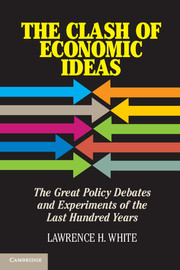Book contents
- Frontmatter
- Contents
- Figures
- Acknowledgments
- Introduction
- 1 The Turn Away from Laissez-Faire
- 2 The Bolshevik Revolution and the Socialist Calculation Debate
- 3 The Roaring Twenties and Austrian Business Cycle Theory
- 4 The New Deal and Institutionalist Economics
- 5 The Great Depression and Keynes’s General Theory
- 6 The Second World War and Hayek’s Road to Serfdom
- 7 Postwar British Socialism and the Fabian Society
- 8 The Mont Pelerin Society and the Rebirth of Smithian Economics
- 9 The Postwar German “Wonder Economy” and Ordoliberalism
- 10 Indian Planning and Development Economics
- 11 Bretton Woods and International Monetary Thought
- 12 The Great Inflation and Monetarism
- 13 The Growth of Government
- 14 Free Trade, Protectionism, and Trade Deficits
- 15 From Pleasant Deficit Spending to Unpleasant Sovereign Debt Crisis
- Index
- References
3 - The Roaring Twenties and Austrian Business Cycle Theory
Published online by Cambridge University Press: 05 June 2012
- Frontmatter
- Contents
- Figures
- Acknowledgments
- Introduction
- 1 The Turn Away from Laissez-Faire
- 2 The Bolshevik Revolution and the Socialist Calculation Debate
- 3 The Roaring Twenties and Austrian Business Cycle Theory
- 4 The New Deal and Institutionalist Economics
- 5 The Great Depression and Keynes’s General Theory
- 6 The Second World War and Hayek’s Road to Serfdom
- 7 Postwar British Socialism and the Fabian Society
- 8 The Mont Pelerin Society and the Rebirth of Smithian Economics
- 9 The Postwar German “Wonder Economy” and Ordoliberalism
- 10 Indian Planning and Development Economics
- 11 Bretton Woods and International Monetary Thought
- 12 The Great Inflation and Monetarism
- 13 The Growth of Government
- 14 Free Trade, Protectionism, and Trade Deficits
- 15 From Pleasant Deficit Spending to Unpleasant Sovereign Debt Crisis
- Index
- References
Summary
The Yale University economist Irving Fisher invented a clever system for easily displaying index cards, later known as the Rolodex. He sold his Index Visible Company for a tidy sum in 1925, amidst the economic boom years known as the Roaring Twenties. In the next few years he turned that sum into a reported $10 million fortune (the equivalent of $132 million in 2011 dollars) by speculating in stocks. Stock prices were rising rapidly, and Fisher’s positions soared. He became known as a stock market prognosticator. On October 15, 1929, he told a dinner meeting audience in New York City, as reported by the New York Times, that stock prices had reached “what looks like a permanently high plateau.” He said he agreed with another observer that “the market may be at its peak now and for several months to come,” but added, “I do not feel there will soon, if ever, be a 50 or 60 point break from present levels, such as [he] has predicted.” Fisher was even more optimistic in the question-and-answer period, saying that he expected “to see the stock market a good deal higher than it is today within a few months.”
Two weeks later the market crashed. Fisher was wiped out, having borrowed heavily to buy stocks on margin. To pay his debts he was forced to sell his New Haven home. He then turned to his sister-in-law for a place to live.
- Type
- Chapter
- Information
- The Clash of Economic IdeasThe Great Policy Debates and Experiments of the Last Hundred Years, pp. 68 - 98Publisher: Cambridge University PressPrint publication year: 2012



